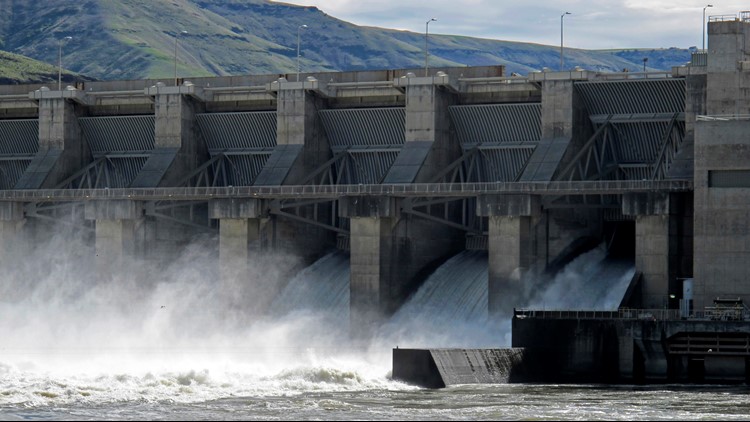A long-awaited federal report due Friday is expected to address the feasibility of removing four hydroelectric dams on a major Pacific Northwest river in a last-ditch effort to save more than a dozen species of threatened or endangered salmon.
The four dams on the lower Snake River in eastern Washington are part of a vast and complex hydroelectric power system operated by the federal government in Washington, Oregon, Idaho and Montana.
The 14 federal dams on the Columbia and Snake rivers together produce 40% of the region's power — enough electricity to power nearly 5 million homes, or eight cities roughly the size of Seattle. They also contain a system of locks that allows cities nearly 500 miles inland from the Pacific Ocean access to Asian markets via barges that float down the massive rivers to the sea.
At the same time, the towering dams have proven disastrous for salmon that struggle to navigate past them on human-made fish ladders as they swim upstream to spawn and die after spending most of their lives in the Pacific Ocean. Salmon are unique in that they hatch in freshwater streams and then make their way hundreds of miles to the ocean, where they spend years before finding their way back to their natal streams to mate, lay eggs and die.
Snake River sockeye were the first species in the Columbia River Basin listed under the Endangered Species Act in 1991. Now, 13 salmon runs are listed as federally endangered or threatened. Scientists also warn that southern resident orcas are starving to death because of a dearth of the chinook salmon that are their primary food source.
The Puget Sound population of orcas — also called killer whales — was placed on the endangered species list in 2005. A mother orca that carried her dead baby on her back for 17 days brought international attention in 2018 as their numbers have dwindled to fewer than 80 animals.
"It's urgent that we do something,” and dam removal works, said Todd True, an attorney for Earthjustice who has represented the Nez Perce Tribe, the state of Oregon, environmentalists and fishing groups in ongoing litigation over the dams.
“We have an opportunity to really do something to comprehensively address this issue and chart a course for the future," he said.
The U.S. government has spent between $15 billion and $17 billion on improved salmon passage over years, but nothing has changed for the salmon, True said. He added that both the Pacific Northwest's power supply and ability to use energy more efficiently have vastly improved in the past 20 years.
The Bonneville Power Administration, which sells the power from the system, “is looking at a very different future than they were 10 years ago, or even five years ago,” he said.
Opponents of dam removal say they want salmon to flourish, but they aren't sure breaching four major hydroelectric dams will help — and it could instead damage the regional economy and the stability of the power supply.
Reservoirs behind some of the dams allow the Bonneville Power Administration to even out the more erratic power supply from wind and solar by spilling water to generate electricity on short notice. And a move away from low-cost coal plants in the Pacific Northwest has some worried about what the future could hold for ratepayers if the Snake River dams are removed, said Kurt Miller, of Northwest River Partners, which represents community-owned utilities across Oregon, Washington, Idaho and Montana.
Ocean warming and acidification from climate change are doing more damage to the salmon than the dams do, he said.
“This is a much, much bigger issue than the Snake River dams. If worldwide salmon populations are doing poorly because of climate change and carbon, does it make sense to tear out 1,000 average megawatts of carbon-free electricity?" he said.
“For so many reasons, it’s bad public policy."
U.S. District Judge Michael Simon ordered the U.S. Army Corps of Engineers, the Bureau of Reclamation and the Bonneville Power Administration to revisit the impact of the hydroelectric system in 2016 while overseeing litigation over salmon.
In all, three federal judges have thrown out five plans for the system over the decades after finding they didn't do enough to protect salmon.



